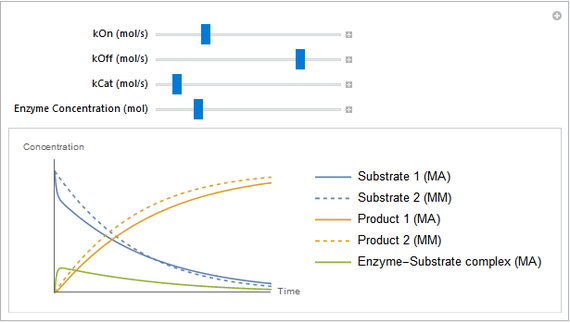Michaelis–Menten Kinetics
To run this example, you'll need
The latest versions of System Modeler and Mathematica.
Please make a selection:
Get afree trial Continue
with download
Introduction
Michaelis–Menten kinetics is one of the most important models for enzyme-substrate interactions. It is used to study the kinetics in a wide array of biological functions, such as the immune response. While a mass action model of an enzyme-substrate interaction would go through an intermediate step with an enzyme-substrate complex, Michealis–Menten kinetics assumes that this complex rapidly enters quasi steady state and can be approximated. This eliminates the need to measure the formation rate of this complex, which is infeasible in practice.
The Model

Visual Representation in SystemModeler
The model has been built in SystemModeler, which results in a visual representation of the model.
The enzyme and the enzyme-substrate complex are implied in the equilibrium description of substrate and product with the help of the Michaelis–Menten rate formula.
where
 Incorporates All Rate Constants
Incorporates All Rate Constants
The Michaelis constant consists of all three reaction rate constants of the regular mass action model, formulated to represent a net reaction flow.

 ,
,
which is called the Michaelis constant, where  ,
,  ,
,  are the constants for enzyme binding, product formation and substrate unbinding, respectively, as seen below.
are the constants for enzyme binding, product formation and substrate unbinding, respectively, as seen below.
E+S 

Simulation
The Model Comes to Life
Explore how the rate constants affect the reaction with dynamic sliders.
The model can be explored using the Manipulate functionality in the Wolfram Language. In the downloadable notebook, you can drag the sliders and see how the system responds.

 and
and  .
.Wolfram System Modeler
Try
Buy
System Modeler is available in English
and Japanese
on Windows, macOS & Linux »
Questions? Comments? Contact a Wolfram expert »
